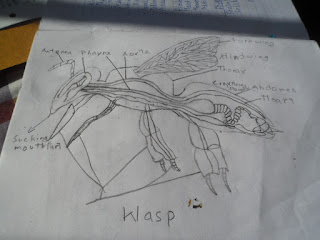The Wasp
vespula Vulgaris
We find a wasp at school and make a study of it.
Kingdom
= Animalia
Phylum
= Arthropoda
Class
= Insecta
Order
= Hymenoptera
Sub
order = Apocrita
Wasps
and honey bees are both members of the Hymenoptera order of insects. They are arthropods. But their physical structures are different. Honey bees do not have
waists while wasps have a distinct waist. Honey bees are hairy while wasps have
smooth and shiny skin.
Amulya and Bishesh look at the wasp carefully.
We found a specimen on our stairs and decided to study it. The young one Vidheha, Bishes, and Amulya were there and so were Utu, Eena, Anita, Teena, and Shila.
Wasps
and bees differ in lifestyle and habits. Honey bee colonies can have populations
over 75,000, while wasp’s colonies tend to have fewer than 10,000 individuals.
Queen wasps build a nest for their colony while worker honey bees create and
maintain hives. Unlike most wasps that hibernate during the winter season and
build a new nest the following autumn, honey bees do not hibernate, as they
live on food reserves and heat accumulated by thousands of workers.
Sushant sir is busy pointing out all the interesting aspects of the wasp.
Wasp
species cannot produce honey. All species of honey bees are capable of
producing and storing sizeable amounts of honey within their hives. While honey
bees sting only once and die after attacking, a wasp is capable of stinging
multiple times and does not die after stinging.
Wasp
species are solitary. Having mated, the adult female forages alone and builds a
nest its own offspring. It cares for its own offspring, steals other wasps’
prey and lays in other's nests. Wasps do
not divide labour. Wasps spend time preparing nests and foraging insects or
spiders for their young. Species may dig burrows in the ground or make mud
burrows. Potter wasps build vase-like nests from mud with multiple cells.
Wasps may have up to three month reproductive cycles. Wasp sting their prey and
then may lay their eggs on it or carry it back to their nest and seal it. It
may feed smaller prey to a single developing larva.
The heart of the wasp is eloooooongated.
Wasps
may lay eggs in the nests of other wasp species. They may paralyze their prey
and lay eggs directly upon the bodies, and the wasp larvae consume them. A few
species transport pollen. Since wasps do not have fur or pollen baskets
like bees, pollen does not stick to them well.
Amulya and Eena's masterpieces.
Honeybees are
relatively quiet. Wasps and hornets are noisy and aggressive. They live
everywhere but Antarctica and can sting over and over again. They chew bark and
form rough paper. A queen starts a new colony each spring. She raises a few
worker wasps first to make the nest larger and bring food. Then she starts
laying eggs. A colony can grow to 50,000 wasps in one summer. In the fall, all
the wasps die except for a few new queens.
Utu and Vidheha's masterpieces.












No comments:
Post a Comment